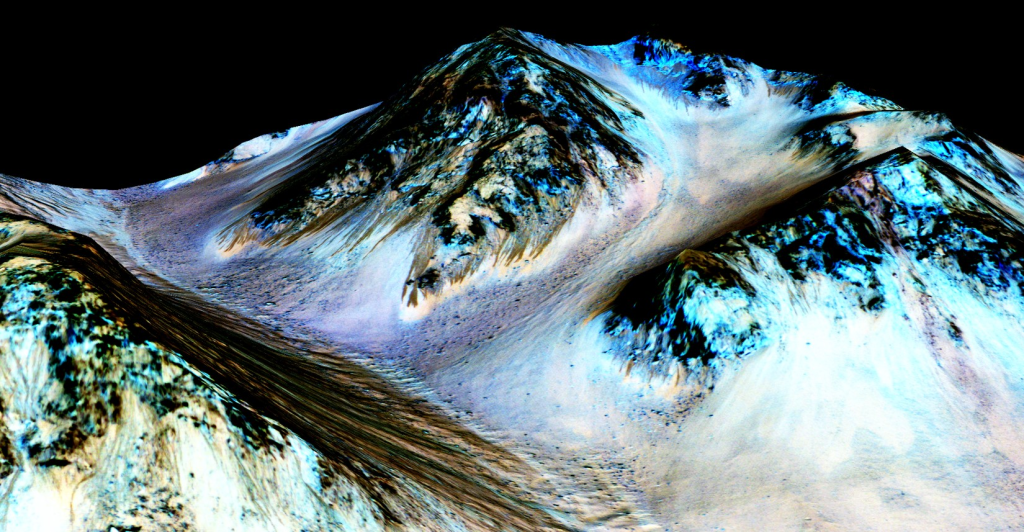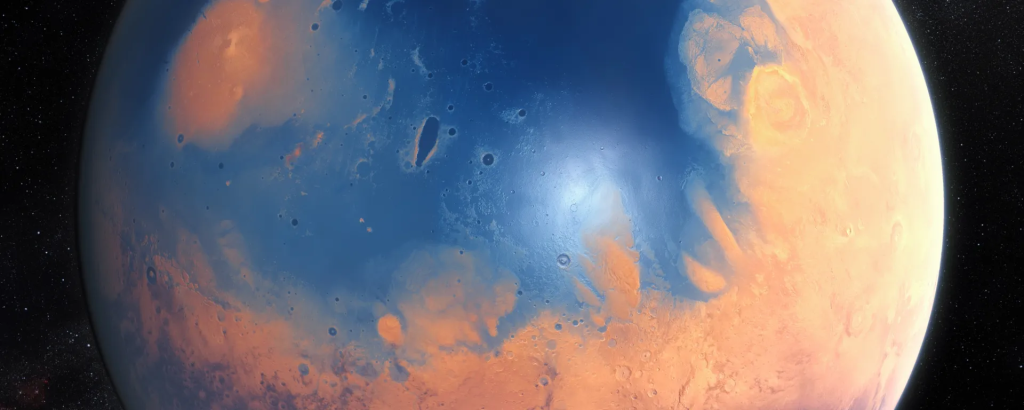
A team of international researchers discovered new data suggesting that liquid water could exist below Mars’ south-polar ice caps. These new findings, published in Nature Astronomy, are the first independent proof that liquid water is present below Mars’ south pole. They were based on information beyond radar. Researchers from the University of Cambridge and the University of Sheffield used laser-altimeter measurements of ice caps’ upper surfaces to discover subtle patterns.
The patterns corresponded to computer model predictions of how an area of water under the ice caps would affect the surface. They are consistent with earlier ice penetration radar measurements which had been interpreted to indicate liquid water below the ice. It has been controversial to interpret the radar data for liquid water. However, some studies have shown that the radar signal does not indicate liquid water.
Frances Butcher, second author of this study at the University of Sheffield, stated that the study “gives the best indication yet that Mars has liquid water today because it means two of the key evidence we would search for when searching on Earth for sub-glacial lake on Earth have now been discovered on Mars.” Butcher explained that liquid water is an important ingredient in life. However, it does not necessarily prove that life exists on Mars.
The researchers pointed out that in order for liquid to exist at such low temperatures, it might be necessary for the water below the south pole to be extremely salty. This would make it difficult to sustain any microbial life. They did however say that it gives hope that there may have been more suitable environments in the past when climates were less harsh. Mars also has thick water ice caps at its poles. They are approximately equal in volume to the Greenland Ice Sheet.

However, unlike Earth’s ice sheets, which are supported by water-filled channels, and even large subglacial Lakes, the polar Ice caps on Mars were thought to be solidified all the way to their bed due to the Martian’s cold climate.
This assumption was challenged by evidence from the European Space Agency’s Mars Express satellite in 2018. The satellite has an ice penetrating radar called MARSIS which can see through Mars’ southern ice cap. It showed a region at the base of ice that strongly reflected radar signals, which was then interpreted as liquid water under the ice caps.
Later studies showed that similar patterns of reflectance could be produced by other dry materials on Mars if they were below the icecap. Because of the cold climate conditions, liquid water under the ice would require additional heat sources, such as geothermal warmth from within the planet.
“The combination of our computer model results and radar data makes it more likely that there is at least one subglacial area of liquid water on Mars today. This means that Mars must still have geothermally active to keep the water below the ice caps liquid,” stated Professor Neil Arnold of Cambridge’s Scott Polar Research Institute.
Subglacial lakes can have an effect on Earth’s surface topography and the shape of the ice sheets that are overlying them. Subglacial lakes have lower friction than the ice sheet’s bed. This affects the velocity of gravity-driven ice flows. This can affect the shape of the ice sheets above the lake. It may cause a depression and then a raised area later down-flow.
The team included researchers from University College Dublin, University of Nantes and University College Dublin.

Their analysis revealed a surface undulation of 10-15 kilometers length consisting of a depression and a corresponding elevated area. These areas both deviate from the surrounding glacier surface by several meters. This is similar to the undulations that occur over subglacial lake on Earth. The team investigated whether liquid water could explain the undulation observed on the ice’s surface.
They then ran computer simulations of ice flows, which were adapted to Mars’ specific conditions. They added a layer of reduced bed friction to the simulated bed of ice sheets, where water (if present) would allow the surface to slide faster.
The amount of geothermal energy coming from the planet was also altered by the researchers. The undulations generated by these experiments were very similar to the ones observed on the real-life ice cap surface. Researchers stated that there was liquid water under Mars’ south pole ice cap because of the similarity in the model-produced topographic undulation to the actual spacecraft observations.
This magmatic activity was observed in Mars’ subsurface to enable enhanced geothermal heating to maintain water in liquid form.
















